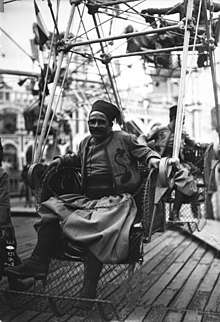Sirwal
Sirwal, also saroual,[1][2] seroual, sarouel or serouel[3] (Arabic: سِرْوَال (sirwāl); Persian: شلوار (šalvâr); Kurdish: شهواڵ (shawal); Urdu: شلوار (shalwâr); Turkish: şalvar; Azerbaijani: şalvar; Kazakh: шалбар (şalbar); Bengali: সালোয়ার (shalwar)), also known as punjabi pants and, in some contexts, as (a subtype of) Harem pants, are a form of baggy trousers predating the Christian era.[4] They are typically worn in Muslim countries, but also extensively in the Greek countryside and other places in the Balkans that were influenced by Ottoman Turks prior to World War II. The trousers are not originally an Arab garment but were introduced from Persia to other Mideastern regions.[5][6] The sirwal is also worn by communities in North India.[7]

_MADDEN%2C_Richard_Robert_in_Syrian_Costume.jpg)
The drawstring allows the sirwal to be worn at either the waist or hip level.
Types
It is usually made from cotton, linen, or polyester. Sometimes the cuff features embroidery.
There are two types of sirwal, long and short. Short sarawil are worn by most Saudi men. Men of the Western Region usually wear long sarawil.
Uniforms

The seroual formed part of the standard uniform for the Mameluke[1][2][8] squadrons of Napoleon's Imperial Guard, and for the North African zouave, spahi and tirailleur regiments of the French Army from 1830 to 1962. The French Army version of the seroual was notable for being cut so widely that it did not require two separate trouser legs. During the American Civil War a number of volunteer regiments, designated as zouaves, also wore seroual breeches, though these were usually of chasseur design, being simply baggier versions of conventional trousers.[3]
References
- Strachan, Edward (2009) Russian Orientalism & Constantinople, p. 150. Sphinx Fine Art At Google Books. Retrieved 23 August 2013.
- Pawly, Ronald (2012) Napoleon's Mamelukes, p. 46. Osprey Publishing At Google Books. Retrieved 23 August 2013.
- Smith, Robin (1996)American Civil War Zouaves, p. 52. Osprey Publishing At Google Books. Retrieved 23 August 2013.
- The word is of Persian origin; [shalwār] (F. Steingass: Persian-English Dictionary, p.758a) was borrowed into Greek as σαράβαρα sarábāra, "loose trousers worn by Scythians" (Liddell & Scott, A Greek-English Lexicon). The words used in Balkan languages came through the Ottoman Turks and did not continue the Ancient Greek designation.
- "Sirwāl" in Walther Björkman (1997), Encyclopaedia of Islam, 2nd ed., volume IX: San–Sze, edited by C. E. Bosworth, E. van Donzel, W. P. Heinrichs and the late G. Lecomte, Leiden: E. J. Brill, ISBN 90-04-10422-4, page 676
- "الثقافة الشعبية". www.folkculturebh.org. Retrieved 17 August 2018.
- Sikh Cultural Centre., (2003) The Sikh Review, Volume 51, Issues 1-6; Volume 51, Issues 589-594
- Thomas, Nigel (2012) Armies in the Balkans 1914-18, p. 23. Osprey Publishing. At Google Books. Retrieved 23 August 2013.